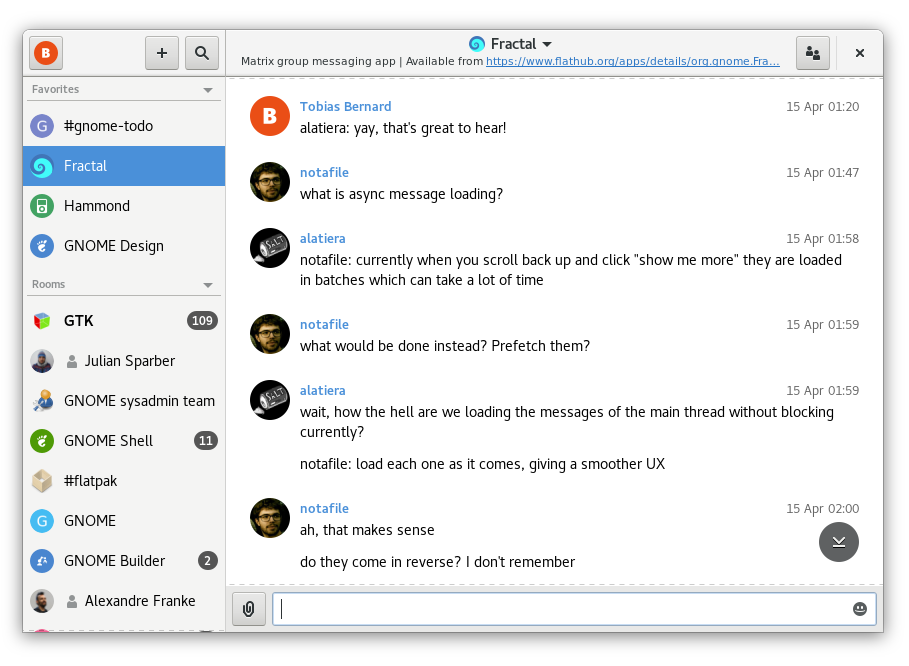tl;dr: Fractal is a new Matrix app for GNOME. Come join our hackfest May 10-13th in Strasbourg!
For the past few months, I’ve been contributing to a new group messaging app called Fractal. Its aim is to be so good that we can maybe, eventually, finally replace IRC as the primary communication channel for GNOME development.
IRC is old
Though IRC has been around forever, it’s hardly a good user experience by today’s standards, and can be a significant hurdle to onboarding new contributors (especially non-technical ones). Some of the main issues are:
- No easy way to use it from mobile
- You can only receive messages while online
- Sending images or files is only possible via URL
This has led to some free software projects going so far as to use proprietary services such as Slack. However, even then you’re stuck with an Electron app, which is slow and not integrated with the desktop at all.
Enter the Matrix
The Matrix protocol is a modern alternative to IRC. It provides features such as persistence, inline media, and multi-device syncing. Importantly for GNOME, it is also backwards-compatible to IRC using bridges, allowing us to use the fancy new Matrix features without being cut off from the rest of the community.
Over the past few years, some GNOME developers have started using Matrix, but the lack of a good native client has held back adoption.

And that’s where Fractal comes in: It’s a native Matrix client for GNOME, with an interface focused on the IRC use case (discussions in large, high-volume rooms). We want it to be a fast, native alternative to Slack that can compete on UX, and doesn’t require non-free network services.
Fractal
I started contributing in late October, when the app was still called Guillotine, and looked like this:

I got involved after Daniel Garcia Moreno, the app’s primary developer, mentioned that he was looking for a designer to help out with his Matrix app on #gnome-design. We then started working on revamping the somewhat haphazardly designed interface, and making it look like a proper GNOME app.
Over the past few months the community has grown from just Daniel and I to over 120 people in our Matrix room, and a number of regular contributors. We’ve redesigned every part of the app (except for the room directory), and added a number of small but essential features, such as invites, room creation, and username autocomplete.
The app now looks like this (though the design is still evolving quite rapidly):

Though it’s still a bit rough, Fractal is already very usable as a day-to-day Matrix client. You can install the Flatpak from Flathub and try it yourself. Bug reports are always appreciated.
The Hackfest
So where do we go from here?
For the past months we’ve mainly been working on overhauling the interface, but we haven’t added many new features. As most of the foundational interface work is done now, we can start planning larger new initiatives.
That’s why next month (May 10th-13th) we’re going to have a Fractal Hackfest in Strasbourg. The core contributors will meet for the first time and discuss exciting new things, such as a better onboarding flow, a new responsive layout, and support for more Matrix features.
Among the people joining the hackfest will be Matthew from Matrix, and some of my coworkers from Purism. It will be a great opportunity for plotting future collaborations.
If you’re interested in joining the hackfest, add yourself to the hackfest wiki page or come talk to us in the Fractal Matrix room.